Kyoto is a city rich in history. However, much of the physical evidence of that history has long since disappeared. It is also a deeply sacred place.
With its narrow streets, mix of old and new architecture, peaceful rivers, and surrounding nature, it is a city that holds on to its past tightly, while embracing the future.
Curious to explore Kyoto beyond the well-trodden tourist routes and sights?
Want to get a glimpse of hidden paths that have each played a part in shaping Kyoto's venerable past?
Then this guide to three short but historical trails (including a full walkthrough video of one of the walks) is a great place to start your journey into these hidden Kyoto walks...
Download a PDF of this Guide:
3 Hidden Kyoto Walks To Get You Off The Beaten Path
by Phillip Jackson
Japan’s ancient capital
Kyoto, founded in 794 as Heian Kyo, was the Imperial City for over a thousand years before Emperor Meiji made the journey east. He came over the mountains to Edo (Tokyo), for an extended stay after the downfall of Tokugawa Shogunate in 1868.
The decision to relocate the capital from Kyoto to Tokyo came not long after in 1889. Today with a city population of almost 1.5 million, Kyoto is still recognized as the cultural centre of Japan. It’s a destination that draws visitors from not just all corners of Japan, but, in normal circumstances, the world.
And, as visitors flock to Kyoto, they will seek out the well known cultural and historical locations from all of the mainstream guidebooks.
But of course, there is far more to Kyoto, Kyoto City and the surrounding areas, than the World Heritage Sites of Kiyomizudera with its impressive wooden viewing platform, the shining Golden Pavilion Kinkakuji, and the famous red-gated Senbon Torii pathway up the mountain at Fushimi Inari Taisha.
In this hidden Kyoto walks post we’ll look at three less well-trodden but equally cultural, scenic, and captivating ‘Hidden Paths’ of Kyoto.
Need help planning your Japan trip?
Visit my Japan Travel Store
WALK 1
The Abandoned Shrine of Mount Oiwa
Start: JR Fujinomori
End: Oiwa Shrine (optional hike to the top of Mount Oiwa)
Distance: 1.7km (Oiwa Shrine only)
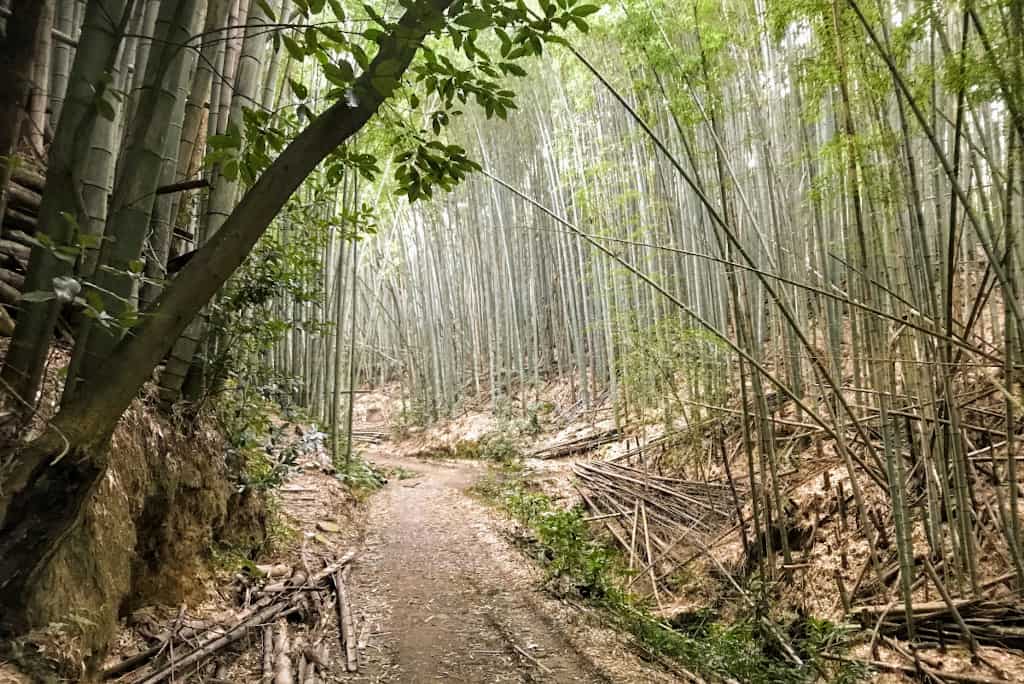
Bamboo groves line the path towards Oiwa Shrine, the holy place of worship of the Kii clan
As mentioned above, the Senbon Torii of Fushimi Inari Taisha is popular with tourists, and gets a mention in every guidebook as the ‘number one place to go’, but just a little further south and still in the Fukakusa area of Kyoto is Mount Oiwa and Oiwa Shrine.
Inari Taisha, from Kyoto Station is reached by the JR Nara Line, just three stops from Kyoto. Stay on the line for one more stop to JR Fujinomori, a little walk, and you’ll come to the entrance of an easy hiking trail up Mount Oiwa.
Also known as Mount Mikakusa (Honourable Grass), it earned this title after grass from the mountain was used to feed the horses of the first Tokugawa Shogun, Ieyasu, when he visited Kyoto in the early 17th century. This route takes you away from the crowds of Inari, and closer to nature over the small mountain and through the now abandoned but fascinating shrine.
Through bamboo groves to a fascinating shrine
As the shrine has been abandoned since 2015, it holds a sense of mystery for those looking for a more adventurous feel over a touristic stroll through well-trimmed greenery.
You will be greeted from the off by bamboo groves as you venture towards the holy place of worship of the Kii clan, who in the 8th century founded Oiwa Shrine. The hiking route is well-maintained and safe, and clear paths are visible all the way to the top of the mountain.
The torii gates, stone and wooden, are dotted along the route, the first at the entrance situated at the base of Mount Oiwa and the second about ten minutes along the trail.
The power to heal
The shrine has been known for its reputed power to heal serious health issues and it is one of its past patrons and his work that many people visit the shrine for. The Kyoto artist Domoto Insho donated two large stone sculpted torii gates after praying for the health of his sick mother.

Kyoto artist Domoto Insho donated two large stone sculpted torii gates to Oiwa Shrine
He donated the first in 1952 when his mother was still alive, and the second in 1963 after her death. More of Domoto’s work can be found at the Kyoto Prefectural Domoto Insho Museum of Fine Arts in the Kita Ward of Kyoto.
Panoramic views of Kyoto and Fushimi Momoyama Castle
The hike from the base of Mount Oiwa to the top takes no more than about 30 to 40 minutes and is suitable for all ages. At the peak is a viewing platform that gives an amazing panoramic view of Kyoto towards the west.

The top of Mount Oiwa offers an amazing panoramic view of Kyoto
Noticeable from here is Fushimi Momoyama Castle. To return to the bottom of the mountain either follow the roads north and south that lead down or retrace your steps back along the woodland route.
SEE ALSO: Hiking and Trekking The Japan Alps and Mount Fuji (Book Review)
How to get here by public transport
To get to this hidden Kyoto walk the nearest train station to the entrance at the base of Mount Oiwa is JR Fujinomori on the JR Nara Lane (which is just three stops southbound from Kyoto Station), from JR Fujinomori Station to Mount Oiwa entrance is a twenty minute walk.
Alternatively, taking the Keihan Line, get off at Keihan Fujinomori, the walk from here to Mount Oiwa is about ten minutes longer but you can take in the Tomb of Ninmyo on the way.
The Abandoned Shrine of Mount Oiwa: Google route map
This route map takes you from the station to the base of the hike up Mount Oiwa. View on Google HERE.
WALK 2
Himukai Daijingu Shrine and Ama no Iwato Cave
Start: Keage Station (subway)
End: Ama no Iwato cave at Himukai Daijingu
Distance: 1km (to Himukai Daijingu Shrine)
Video: Click to watch a video of this walk

Himukai Daijingu, Kyoto’s Ise - the ‘sun-facing’ shrine
Most people that use the Keage Subway Station are doing so to visit the Keage Incline, famed for its cherry blossoms, or to head in the direction of Nanzen-ji. But there is another interesting location that attracts far fewer tourists.
Himukai Daijingu, Kyoto’s Ise, the ‘Sun-facing’ shrine as it looks south. Founded in the 5th century during the reign of Emperor Kenzou when the deities of Mount Takachiho in Himuka, Miyazaki were relocated here.
Enshrining Amaterasu - the Shinto Sun Goddess
According to legend, the soul of the Shinto Sun Goddess, Amaterasu, leapt to this location from Mt Takachiho. Takachiho is steeped in Japanese mythology. It is the supposed site in folklore where Amaterasu, angered by the misdeeds of her younger brother, Susanoo, shut herself away into a cave, Ama no Iwato, plunging the Earth and Heavens into darkness.

Himukai Daijingu's inner shrine is said to enshrine the Sun Goddess Amaterasu
The inner shrine of Himukai Daijingu enshrines the Sun Goddess Amaterasu, as well as the Munakata sanjojin (three Munakata goddesses). These kami (gods) are believed to be daughters of Amaterasu (and also from some sources the daughters of Susanoo (the younger brother of Amaterasu)), and are deities of seafaring and road travelling safety.
Heavenly Gods and primaeval chaos
The outer shrine enshrines Ninigi no Mikoto and Ame-no-Minakanushi. Ninigi no Mikoto is deified and worshipped for good fortune in farming. Whereas Ame-no-Minakanushi was described in the Kojiki (an early chronicle of Japanese myths and legends) as ‘the first god to appear in the heavenly realm of Takamagahara (High Plain of Heaven, Abode of The Heavenly Gods), after the emergence of Heaven and Earth from the primaeval chaos’.
The shrine records of Himukai Daijingu were, like many other shrines and temples in Kyoto, lost during the Onin War of 1467-1477. The shrine itself was also lost to fire but a temporary building was put in its place to keep the shrine running and the shrine was eventually reconstructed properly in the late 1500’s to early 1600’s by the Shogun Tokugawa Ieyasu after Noro Munemitsu of Ise Shrine received a vision from the Gods in one of his dreams instructing it.
VIDEO: Hidden Kyoto - Himukai Daijingu Shrine and Ama no Iwato Cave
A place of rest along the historic Tokaido Road
As a point along the Tokaido Road, the ‘eastern sea route’ connecting Kyoto to Edo, the shrine became a popular place for travellers to stop and pray for safety on the journey. Himukai Daijingu also sits beside the route of part of the ‘Kyoto Hiking Trail’.
Once at the top of a large set of stone steps and through the torii gate that marks the entrance to the shrines of Himukai Daijingu we find ourselves in a spacious precinct area of the shrine that also houses a ‘kagura-den’, a stage platform usually used for Noh or sacred dance (kagura).
Take a few minutes to enjoy the beauty of the precinct, a moment at the outer shrine and surrounding woodland before heading straight on and over a small bridge to the main inner shrine. Once over the bridge, more stone steps lead up to the inner shrine.
The Ama no Iwato cave ‘power spot’
As mentioned earlier, the main focus of the shrine is the Sun Goddess Amaterasu, and steps by the inner shrine lead to the Ama no Iwato cave.

Kyoto Ama no Iwato cave is close to Himukai Daijingu Shrine
The Ama no Iwato cave at Himukai Daijingu does not have the same importance as the Ama no Iwato in Miyazaki, and it was no doubt carved out of the rock here due to the legend that Amaterasu’s soul leapt from Takachiho to Himukai Daijingu. It is, though, an integral chapter of the stories of Amaterasu, and many people name it as a strong ‘power spot’ in Kyoto.

Ama no Iwato cave entrance
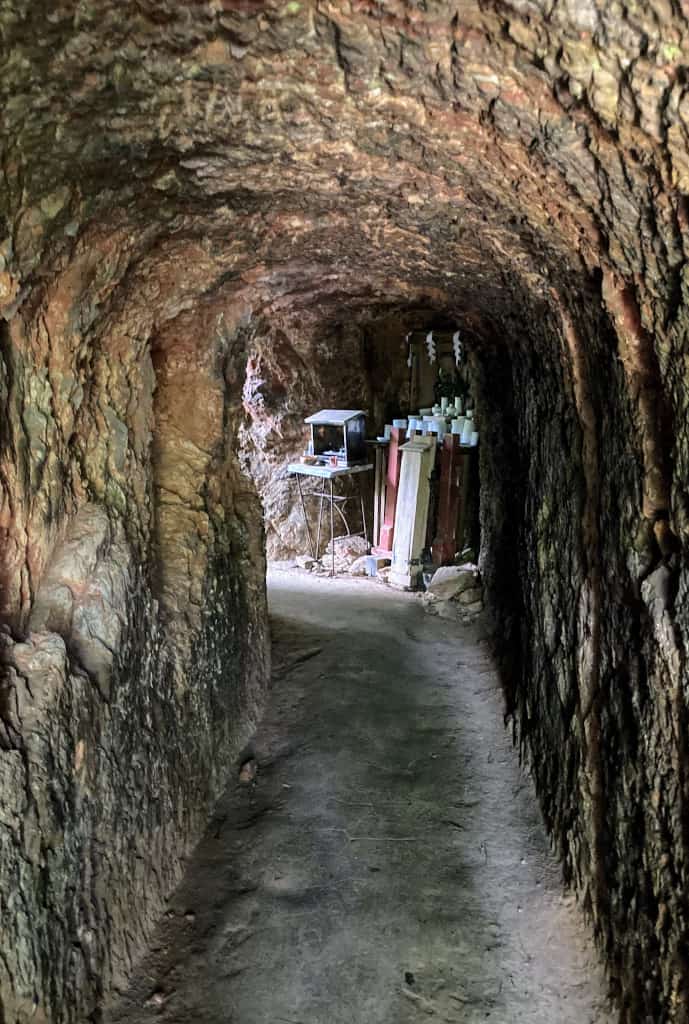
Inside Ama no Iwato cave

Ama no Iwato cave exit
The cave route is short, just a few metres in it turns sharply to the left, whereafter it leads out to the exit, in the corner is a small shrine. This shrine is associated with Togakushi Shrine in Nagano and is dedicated to Ame no Tajikarao, a God of strength, often prayed to for fortune in sports, and is said to have been the god that pulled Amaterasu from her cave hideaway at Takachiho.
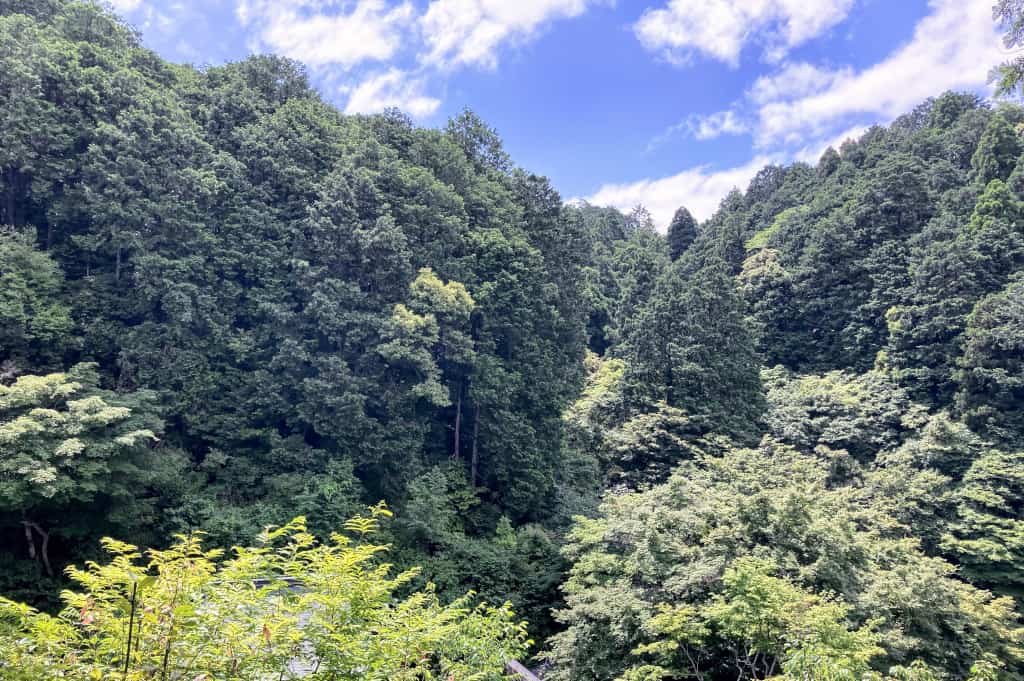
View over Mount Shinmei to the east, and the buildings of Himukai Daijingu below
Connected to this cave is also the thought by some that passing through offers good luck and the warding off of evil spirits. From here you can take in a great view over the surrounding woodland covered Mount Shinmei to the east, as well as the buildings of Himukai Daijingu below.
BONUS: Click Here to watch a video of this walk (includes an exact location map using Google Earth). There's also another version of the video that (if you prefer) has no on-screen captions, which you can watch here.
How to get here by public transport
To get to this hidden Kyoto walk for Himukai Daijingu you will need to take the subway to Keage Station, which is just two stops east from the convenient Sanjo Station also connecting with the Keihan Station and Keihan train lines.
Himukai Daijingu Shrine: Google route map
This route map takes you from Keage subway station to Himukai Daijingu Shrine. View on Google HERE.
WALK 3
Jonangu Shrine
Start: Takeda Station
End: Jonangu Shrine
Distance: 1.3km
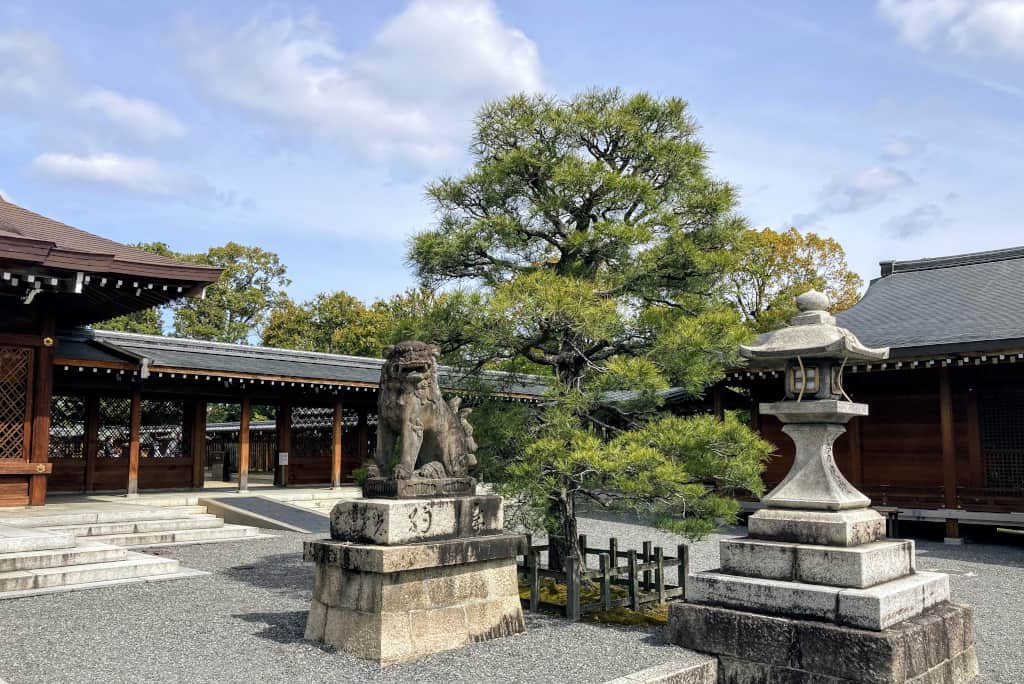
Originally constructed in 794, Jonangu is known as 'the shrine south of the capital’
‘The shrine south of the capital’, a shrine that mainly due to its location is often overlooked by visitors to Kyoto, Jonangu was originally constructed in 794 as a shrine to protect the new city of Heian Kyo (Kyoto).
Renowned as a shrine dedicated to the female deity of safe childbirth, successive emperors in the past have visited to pray for the peace and security of the city and court.
A popular retreat for the imperial family
The Toba area in which Jonangu sits, at one time was a popular retreat for imperial family members and aristocrats, and visitors to Jonangu can also find that close by is the Tomb of Emperor Shirakawa (11th century).

A short walk from Jonangu, towards the Kamo River sits the Toba Rikyu ato Park
Jonangu is also known for its extensive garden that surrounds the shrine, offering striking displays throughout the year, notably during the plum and cherry blossom periods. In the spring (April) and autumn (November) Kyokusui-no-utage festivals are held, a ceremony of sake drinking and poetry writing by a stream that dates back to the Nara era, especially in the 8th century.
There are also other events to be found at Jonangu during the year such as Yabusame, horseback archery.
This area has something for everyone
But what’s appealing about Jonangu is that, not just the shrine, but the surrounding area has something for everyone.
Those looking for the religious culture and the gardens will find them at the shrine, and those looking for sites of historical conflicts that have plagued Kyoto over the centuries will discover one of the most notorious locations right here.

A monument on a hill in the park corner is a reminder of the history
Because it was at Jonangu where on January 27th 1868, that the Satsuma cannons were lined up at the start of the Battle of Toba Fushimi that would begin the Boshin War of 1868-69. A war which effectively dictated the future of Japanese politics for the next half century and more.
SEE ALSO: Feel the Spirit of the Samurai Sword in Kyoto
The battle of Toba-Fushimi
A short walk from Jonangu, towards the Kamogawa (Kamo River) sits the Toba Rikyu ato Park. The park is calm and relaxing, with a children’s playground, and a baseball pitch, but it’s also the location of the Emperor Shirkawa’s 11th century villa, as well as being the site of part of the Battle of Toba-Fushimi.
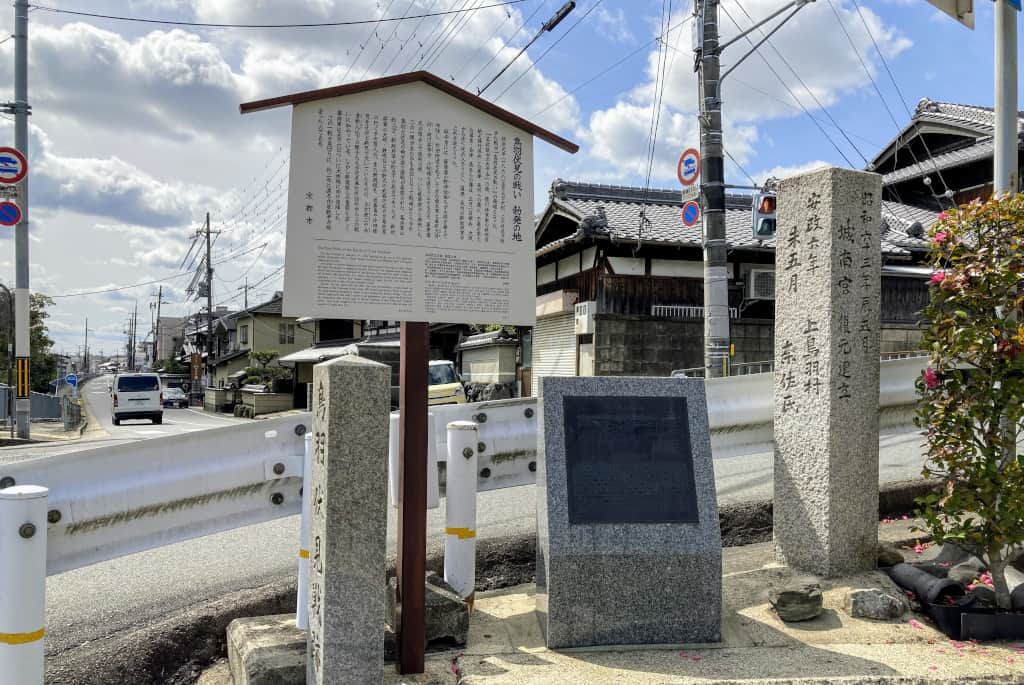
A stone marker at Koeda Bridge explains the Battle of Toba Fushimi in 1868
A monument on a hill in the park corner is a reminder of the history, and a path beyond leads to Koeda Bridge where the first shots were fired by Satsuma forces at the advancing Shogunal side. Bullets against swords, it was a massacre.
At the base of the east side of Koeda Bridge can be found a stone marker and signpost explaining the background to and events of January 27th 1868 and the Battle of Toba Fushimi.
How to get here by public transport
To get to this hidden Kyoto walk, Jonangu Shrine can be reached by taking the Karasuma Line train from Kyoto Station southbound to Takeda Station, which takes around 15-20 minutes depending on the time of day. From Takeda Station it is a 15-20 minute walk to Jonangu Shrine.
Jonangu Shrine: Google route map
This route map takes you from Takeda train station to Jonangu Shrine. View on Google HERE.
Opening the door the the curious
This brief article is intended merely as a taster to the many hidden Kyoto walks that exist. A guide to open the door to the curious who want to see some of the city and suburbs that may be hidden by either time or modern life.
Regardless of whichever part of Kyoto you find yourself in, you will always find a story. Hopefully you will use these three suggested hidden Kyoto walks as a starting point, perhaps taking it upon yourself to delve deeper.
Take your time to enjoy the journey. And, most of all, enjoy exploring Kyoto!
All photos Copyright © Phillip Jackson

About the Author
Phillip Jackson is the writer of the HIDDEN PATHS - Walking Historical Kyoto series of walking guidebooks, along with the companion book PARANORMAL KANSAI - Mysteries & Unexplained Stories of West Japan. Specialising in off the beaten track walking routes of historical, cultural, and natural interest, Phillip is the founder of www.hiddenpathskyoto.com.
Amazon Idea List - Phillip Jackson's Hidden Path walking guides
If you enjoyed this post about hidden Kyoto walks, be sure to check out our Amazon Idea List of author Phillip Jackson's Hidden Path walking guides to Kyoto and more...
Resources
Download a PDF of this Guide:
Hidden Kyoto Videos
HIDDEN KYOTO: Himukai Daijingu Shrine and Ama no Iwato Cave (With Info Captions)
HIDDEN KYOTO: Himukai Daijingu Shrine and Ama no Iwato Cave (Without Info Captions)
Further Reading
Kyoto City Guide
Why You Should Explore Kamigamo Shrine In Kyoto
Stardust Vegan Cafe & Boutique, A Kyoto Oasis
Top 6 Best Kyoto Cycling Tours
Why You Should Try Exploring Kyoto Train Station
Feel the Spirit of the Samurai Sword in Kyoto
Experience Japanese Tea Ceremony in Kyoto
Hiking and Trekking The Japan Alps and Mount Fuji (Book Review)
Hidden Paths Kyoto website
http://www.hiddenpathskyoto.com
More Experience Resources
My List of Recommended Japan Travel Resources
The Real Japan Travel Store
If you enjoyed this article please share this image online:





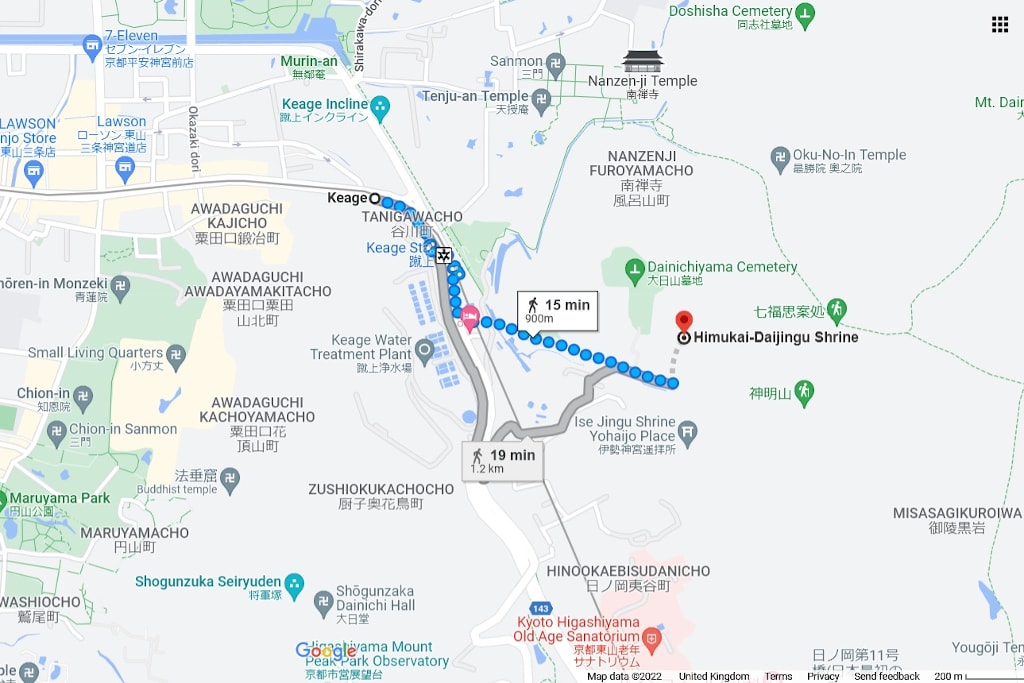

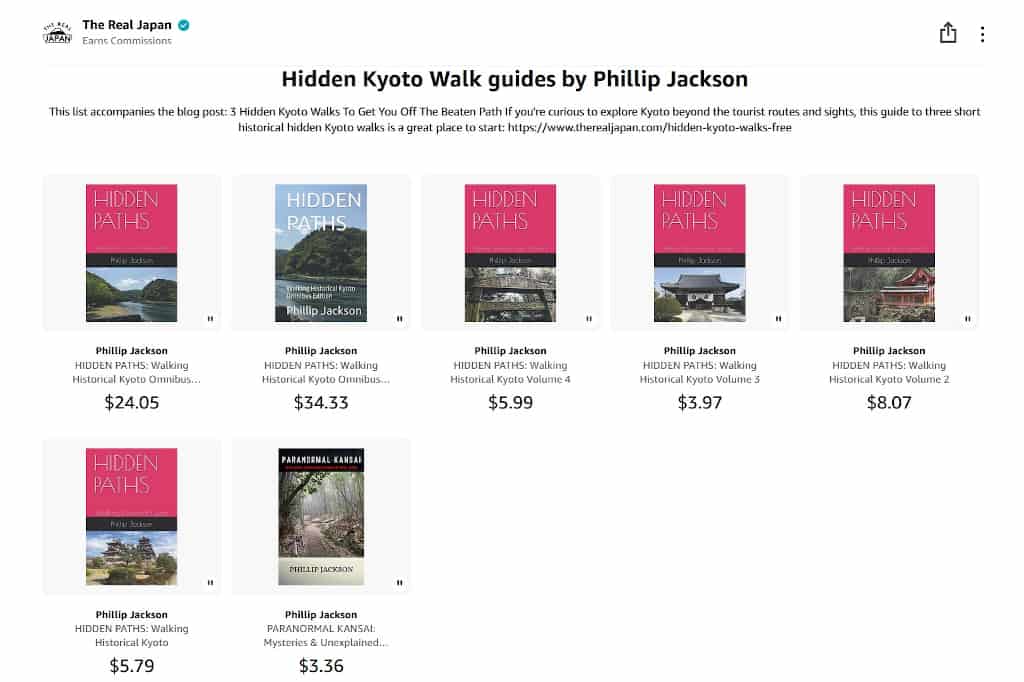
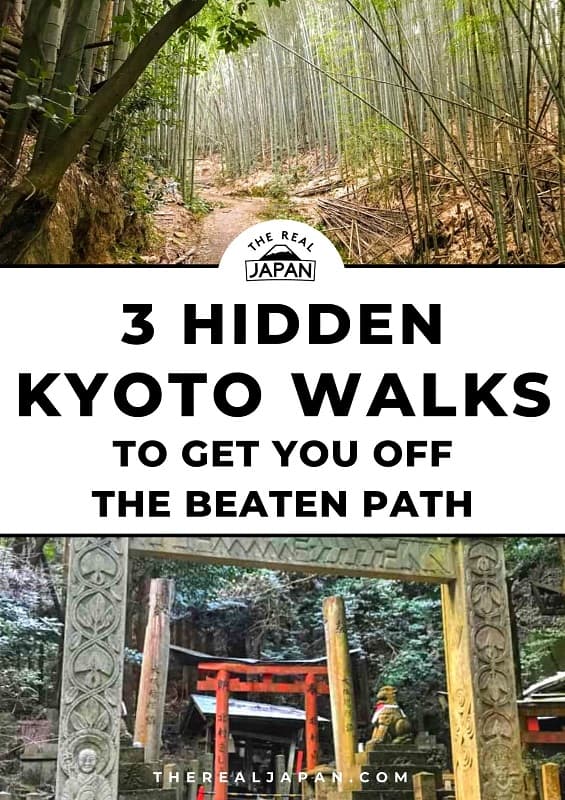
So much to see and do in Kyoto. Had not realized the richness of Kyoto on my previous visit. Don’t know if I can revamp my itinerary now.Saving this information for a future visit.
Thanks,
Anjali
Thanks for your comments Anjali. I hope you can make use of this post for your next trip to Kyoto. And be sure to check out Phillip’s guide books.
Another interesting post from Real Japan! I always like to visit places not on most people’s itineraries and Kyoto (both city and prefecture) has many of these places and this article gives more ideas!
Thanks Steve – that’s precisely what I wanted to achieve by asking Phillip to create the post!
How difficult are these walks for the 65 and up people?
Dear Eileen, thanks for the comment. All three of these walks are ideal for all ages (including 65 up). The most arduous of the three is Mount Oiwa (the first on this blog), but the hiking route is well maintained even though the shrine is abandoned. The second to Himukai Daijingu is a walk that rises very gradually from the start to the shrine, and the walk to Jonangu Shrine and the site of the Battle of Toba-Fushimi is a level route. Take the walks at your own pace and you’ll have no problem. Enjoy. Phillip Jackson.